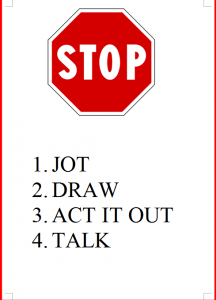As I sat in staff development today, I heard the presenter use this phrase, “writing pulls up reading.” Pretty powerful if you think about it right? The act of reading does not pull up writing—but the act of writing does pull up the knowledge of what a person has read. He shared that students by the end of high school should be able to read informational text and express the main points by writing 1500 words on the topic. Are we preparing our kids for this?
Within this workshop, 8 strategies that have been proven to be effective and yield high growth were shared. One of these is summarizing. When we think of summarizing, we think of writing a summary but this concept is a bit different and ties in VERY well to our school wide goal of student interaction. Summarizing can be effective for learning when it is used to break up a lesson, story, or activity and students are asked to summarize before, during and after instruction. A child’s attention span is their chronological age plus one; think about our 90 minute math block or 120 minute reading block. Breaking this up into chunks is great but is providing center time always the answer?
If you are teaching or reading, simply stop and have students summarize with a partner or stop and write their thoughts and then discuss. The act of summarizing and stopping to synthesize information actually reboots the brain and prepares it for more learning. So, by stopping every 7-9 minutes, to think, write or talk about learning—you are maximizing learning for students AND layering learning. You are allowing information to be processed and then you can build on those ideas after debriefing whole group. These mini discussions or writing tasks are actually having students “write or speak to inform” which is what we want them to do as students who are graduating and reading 1500 words—right?
This information made me think of an earlier blog post about a strategy to make reading more interactive. This strategy allows students to synthesize learning, interact with the information and then prepare for more information. The strategy does not have a formal name to my knowledge but I used it in the classroom and called it Stop Draw, Act, Write and Talk.
As you read, it is important to have ongoing interaction with the students and not having them listen passively. You can have students make responses verbally or in written form. They can create story maps, think pair share, partner discussions, act out, reflections, etc. I used to keep a poster in my room with the following words: STOP Draw, STOP Act Out, Stop Jot, and Stop and Talk. These are the options students could use to participate as we read and made notes in their reading journals.
I challenge you for the month of December to begin to use this strategy during whole group reading to allow students to truly take the information, summarize it and apply it in different ways (talking, acting, writing, etc.) It is important for our students to take knowledge in through reading or listening and to practice paraphrasing their learning into a summary and then use it in a new way.
Printable Poster for Interaction: posterread-aloud-11eqc1n-1
